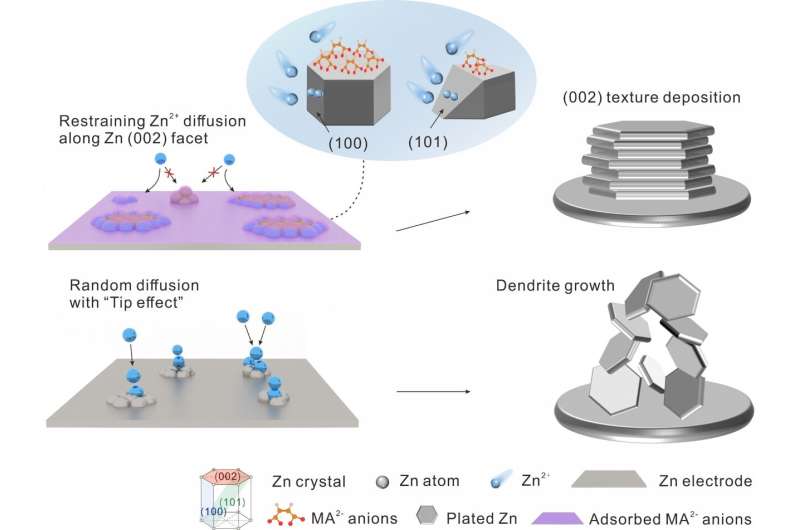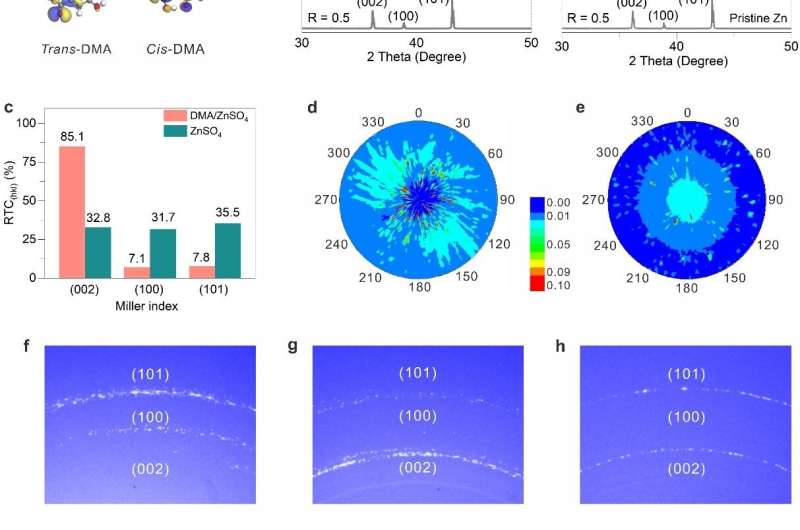This article has been reviewed according to Science X's editorial process and policies. Editors have highlighted the following attributes while ensuring the content's credibility:
fact-checked
peer-reviewed publication
trusted source
proofread
Novel strategy stabilizes zinc-ion batteries

According to a study published in Advanced Functional Materials, a research team led by Prof. Hu Linhua from the Hefei Institutes of Physical Science of the Chinese Academy of Sciences found that adding disodium maleate (DMA) to the electrolyte of aqueous zinc-ion batteries would lead to the growth of the preferred Zn (002) texture, which could effectively inhibit the growth of zinc (Zn) dendrite and improve the reversibility and cyclability of batteries.
"This means that the DMA can stop harmful zinc dendrites from growing and improve the ability of batteries to be recharged and used multiple times," said Dr. Li Zhao Qian, a member of the team.
Today, aqueous zinc-ion batteries (AZIBs) have attracted widespread attention for their safety, reliability, and cost-effectiveness. Strong Zn dendrite growth and severe side reactions have become the main obstacles to the widespread commercialization of AZIBs.
The Zn (002) crystal plane has a smooth surface atomic arrangement, uniform interfacial charge density and low surface energy, which favors the uniform Zn2+ deposition and better anticorrosion performance. Therefore, tuning the states of the plated Zn crystal holds great promise for achieving highly stable and reversible metal anodes.
In this study, the researchers have developed an electrocrystallization strategy to induce Zn (002) texture growth. The adsorption of DMA induces Zn (002) texture growth and inhibits harmful side reactions.
"When we tested the battery, it was able to work for over 3,200 hours, even when used at high power levels," said Dr. LI Zhaoqian.

They tested it under harsh conditions of 30 mA cm-2 and 30 mAh cm-2, and the Zn anode exhibits an ultra-long cycle life of 120 hours.
They also tested the battery with different materials and found that it worked well with them, even after many cycles. They assembled Zn//Cu batteries with an average Coulomb efficiency of 99.81% after 3,000 cycles. Meanwhile, the Zn//NH4V4O10 full battery delivers a long-term stability with capacity retention of 92.3% after 10,000 cycles.
This study tailors the migration behavior of Zn2+ at different crystal planes by adsorbed DMA molecular layer to induce Zn (002) crystal growth, which provides a promising strategy to achieve the dominant texture of zinc anode at the molecular level, and should be expected to be applied to other metal anodes.
More information: Tingting Wei et al, Building Near‐Unity Stacked (002) Texture for High‐Stable Zinc Anode, Advanced Functional Materials (2023). DOI: 10.1002/adfm.202312506
Journal information: Advanced Functional Materials
Provided by Chinese Academy of Sciences





















